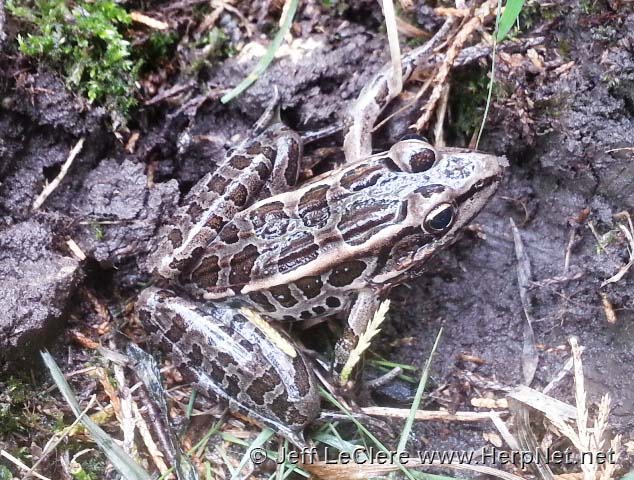Pickerel Frog (Lithobates palustris)
Alternate names: Rana palustris
by Jeff LeClere

Pickerel frogs, Lithobates palustris, calling.
Status
Species of Greatest Conservation Need. A valid fishing license is required to possess this species for bait or food. Found along streams in eastern Iowa.
Description
The pickerel frog is a medium sized frog about 3 inches in body length. Adults are tan or brown (never green) with four to five pairs of squarish brown spots. They have complete light gold dorsolateral ridges down the back. The belly is plain white. There is a distinctive yellowish wash in the groin areas and the thighs. There are brown tiger stripes on the hind legs.

The pickerel frog could be confused with the very similar leopard frogs. Unlike leopard frogs, pickerel frogs are always brown (leopard frogs, except plains leopard frogs, may be green or brown), have square spots arranged in pairs on the back, a yellowish wash on the thighs (all leopard frogs usually have a greenish wash), and are only found in eastern Iowa.
Subspecies
There are no subspecies of the pickerel frog, Lithobates palustris.
Range
The pickerel frog is found in eastern Iowa, fairly close to the Mississippi River even in the westernmost parts of its Iowa range.

Habitat
Pickerel frogs are most commonly found in rivers or clear water trout streams. They may be found in small ponds or wetlands, but usually these are near rivers or streams. They breed in ponds and pools adjacent or connected to streams and rivers.
Habits
Pickerel frogs breed in spring (late April, May, and June). The males call is a deep snore. It is shorter and higher pitched than the northern leopard frog’s call and is usually not followed by a chuckle as in leopard frogs. They call from the shore or from underwater in shallow portions of the wetland. Females lay 2,000 to 3,000 eggs. The tadpoles transform in two or three months.

Pickerel frogs usually stay close to the water. Few move into wet terrestrial habitats. I have seen pickerel frogs away from streams in damp, forested uplands in Allamakee and Clayton counties. These are usually large adults that will not dehydrate as quickly as smaller specimens. They overwinter in streams or rivers or may migrate to shallow ponds, if close. Pickerel frogs apparently produce toxic skin secretions that are distasteful and harmful to predators. The toxin is reportedly fatal if it is absorbed through the skin as other frogs (even other pickerel frogs) have been killed when they were placed in a small container with pickerel frogs.
Food
Pickerel frogs consume insects, earthworms, and other invertebrates.


